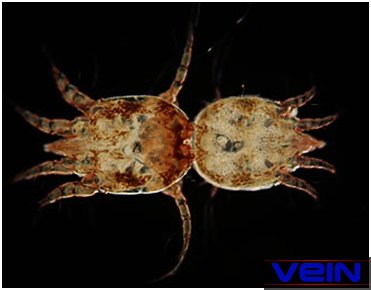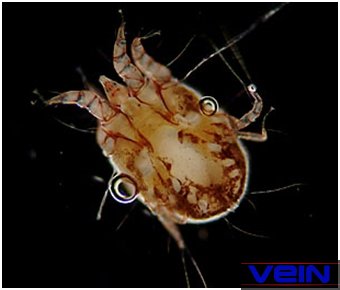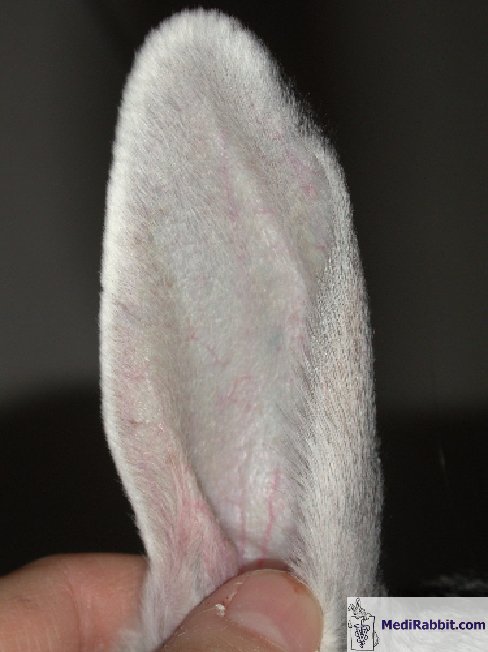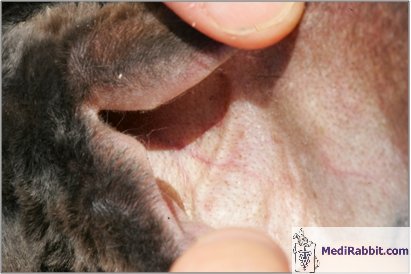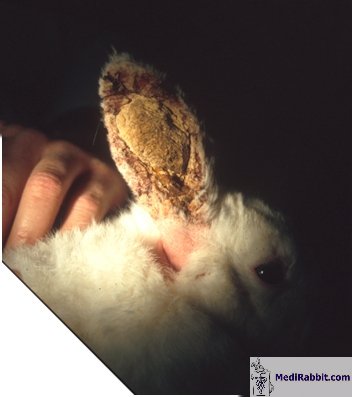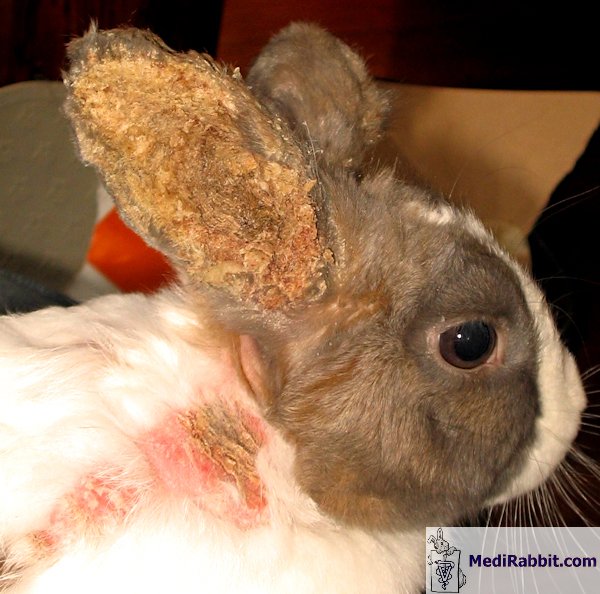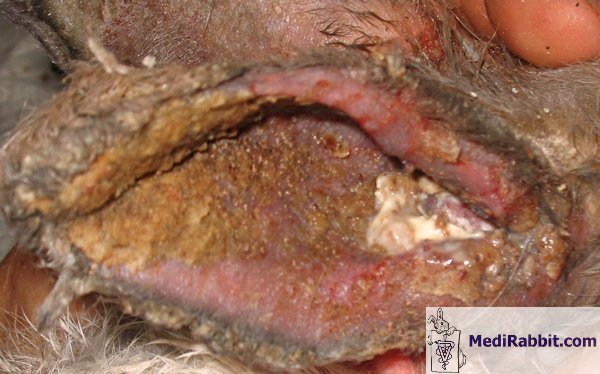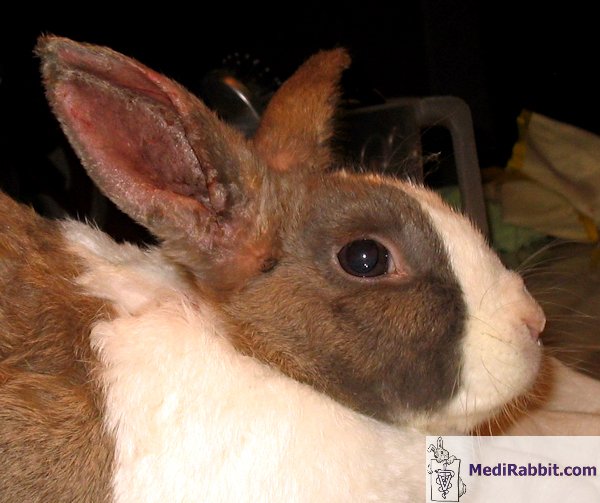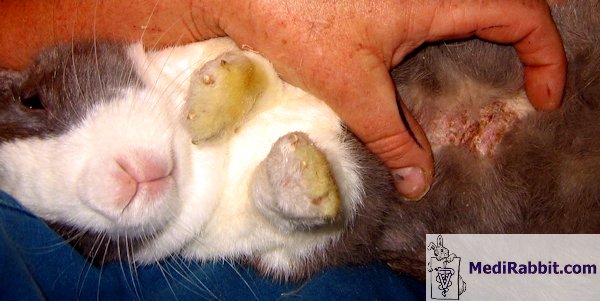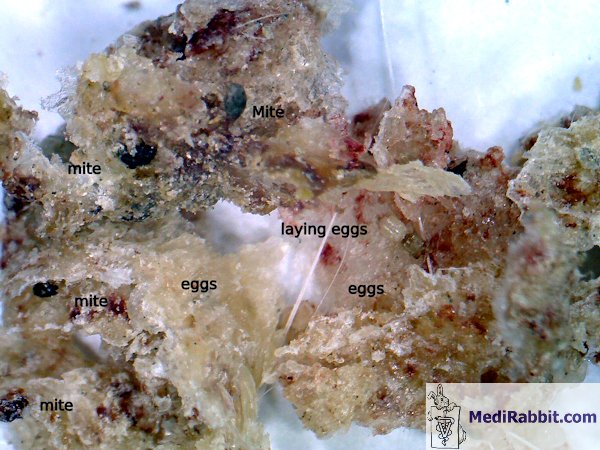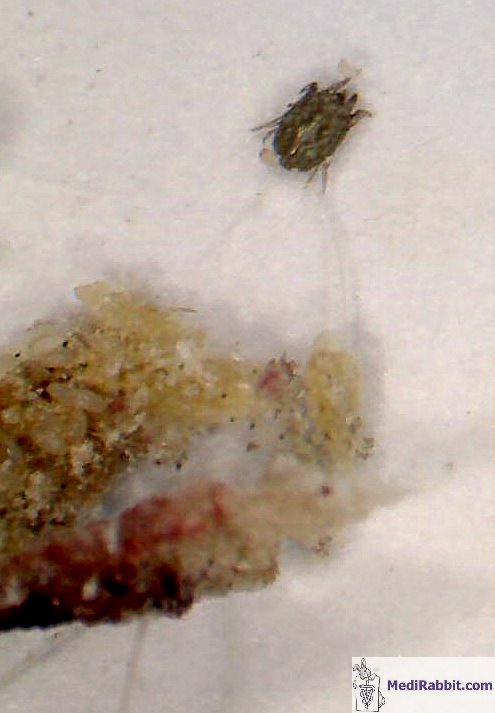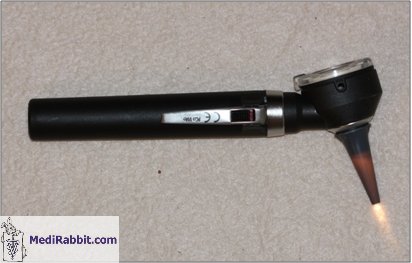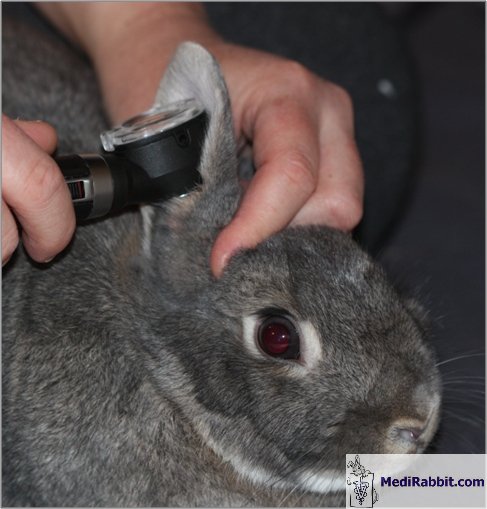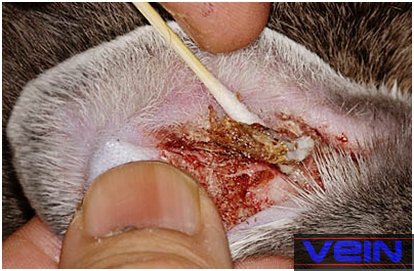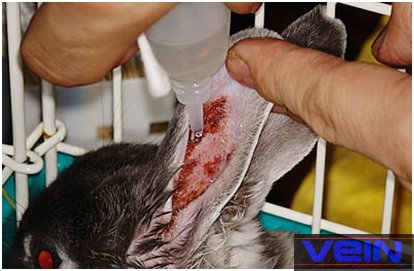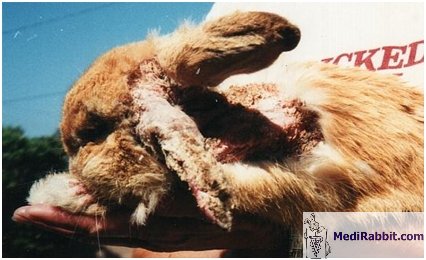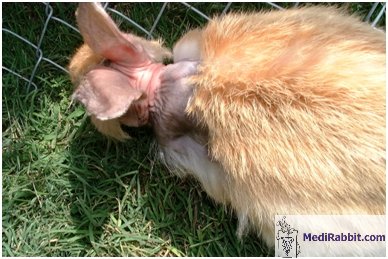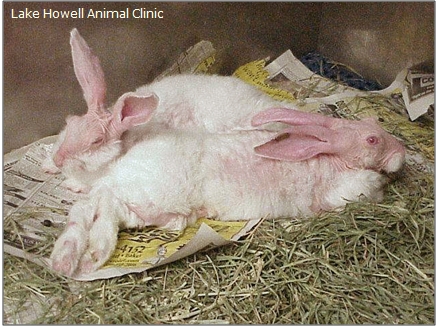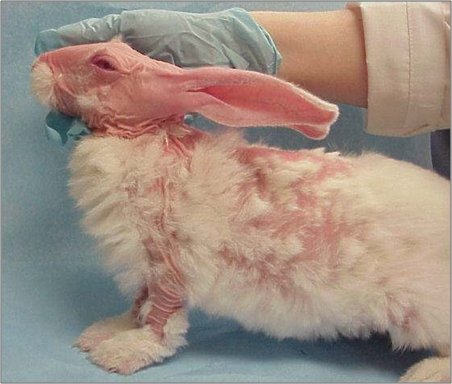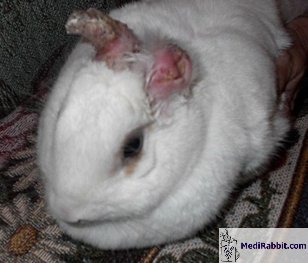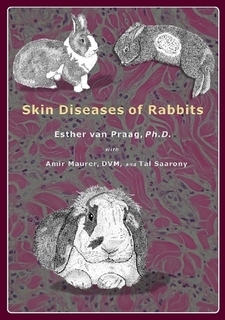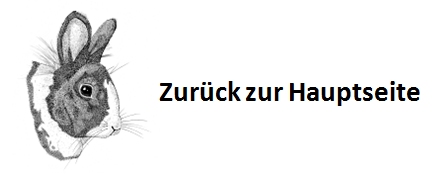Ohr-Milben: Psoroptes cuniculi
Esther van Praag, Ph.D.
- Übersetzung:
Susanne Weegmann
MediRabbit.com wird nur dank den
Grosszügigkeit der Spender finanziert.
Jede Spende, egal
wieviel, wird geschätzt und wird die ständige MediRabbit.com medizinischen Forschung über Versorgung und
Gesundheit der Kaninchen helfen.
Danke
|
Warnung:
Dieser Text könnte Bilder enthalten die für empfindliche Personen nicht
geeignet sind.
Die Ohrmilbe Psoroptes cuniculi
ist ein weltweiter Parasit. Sie hat verschiedene Lebensstadien: Ei,
Larve, Protonymphe, erwachsene Milbe. Der Zyklus dauert, abhängig
von den Umgebungsbedingungen, ungefähr 21 Tage, die Eier brüten nach
4 Tagen.
Psoroptes cuniculi befällt hauptsächlich die Ohrmuschel
der Kaninchen und es ist dabei nicht selten festzustellen, dass nur
ein Ohr betroffen ist. Bei älteren oder kranken oder nicht ausreichend
behandelten Tieren, kann der Parasit sich ausbreiten, und den Kopf,
das Genick, die Beine und den perianalen Bereich befallen. Der Schleim
und die fäkalen Stoffe des Parasiten verursachen eine Entzündung,
die dazu führt, dass das Kaninchen
beginnt sich am Ohr zu kratzen. Das Blut, welches aus den Kratzwunden
austritt, dient als Nahrungsquelle für die Parasiten.
Klinische
Zeichen
Symptome sind juckende
Ohren, häufiges schütteln des Kopfes und kratzen bis zur Selbstverstümmelung.
Am Anfang bilden sich tief im Gehörgang und an den Ohrläppchen kleine,
fest anhaftende Hautschuppen, die von haarenden (kahlen) Stellen umgeben
werden. Diese gelb-grauen Schuppen können ziemlich dick sein; sie
bestehen aus einer große Anzahl der Parasiten, Milbenfäkalien, Hautzellen
und Blut.
Wenn
in diesem Stadium keine Behandlung erfolgt, wachsen die Schuppen zu
Krusten und können in extremen Fällen eine Dicke von bis zu 2cm erreichen.
Das Ohr ist nicht länger im Stande zu stehen und fällt. Die Schuppen/Krusten
sollten in keinem Fall entfernt werden; wenn sie entfernt werden,
hinterlassen sie eine blutige zerfressene Haut. Die Kruste löst sich,
ohne dass man die Ohren säubern muss, von selbst auf und fällt normalerweise
innerhalb von 10 Tagen nach der ersten Verabreichung von Ivermectin,
oral oder injiziert, ab. Earlier removal
is also very painful, and may lead to screaming.
Video
by D. Hanson Oft werden Schmerzen
im äußeren Gehörgang und den umliegenden Bereichen beobachtet.
Die Wunden, die durch Ohrmilben verursacht werden, können
sich entzünden, jedoch ist eine solche Entzündung nicht immer zwangsläufig.
Ohne Behandlung werden sich die Bakterien ausdehnen und eine hyperkeratotische
(anormale Verdickung der Haut) Otitis externa (Außenohrentzündung)
verursachen. Wenn es unbehandelt bleibt, kann sich die Entzündung
nach innen ausdehnen, ein Reißen des Trommelfells und nachfolgend
eine Innenohrentzündung hervorrufen.
Diagnose
Eine visuelle Untersuchung
ist nicht immer ausreichend, um das Vorhandensein von Milben zu bestätigen.
Man kann die Klebebandmethode oder Hautabschabungs-Methode verwenden.
Eine Probe von der Abschabung oder Einsaugung wird in Kaliumhydroxid
aufgelöst, auf einen Mikroskopträger aufgetragen und unter dem Mikroskop
untersucht. Die Chance ist groß, dass man zumindest eine Milbe, eine
Larve oder Eier entdeckt. Haarproben können ebenso in Kaliumhydroxid
aufgelöst werden und unter dem Mikroskop nach Eiern untersucht werden.
Wenn in der ersten Probe keine Milbe gefunden wurde, sollte man an
anderen Stellen des Körpers suchen.
Behandlung
Die Schuppen/Krusten
sollten in keinem Fall entfernt werden !!!
Removing
them is horribly painful to the rabbit, leading to screaming (see
video).
Ohrmilben werden
mit Avermectine behandelt:
•
Ivermectin: 0.4 mg/kg, PO (oral)
oder SC (subkutane Injektion), 3 mal in Intervallen von 14 Tagen (der
Lebenszyklus von Psoroptes cuniculi
dauert 21 Tage); 200µg/kg wurde als unwirksam befunden.
•
Selamectin: Revolution® (USA) oder Stronghold® (Europa) – Pfizer,
18 mg/kg. Eine einzige oberflächliche (lokale) Dosis sollte ausreichen;
wenn nicht nach 30 Tagen wiederholen.
•
Moxidectin (Quest® or Equest® - Fort Dodge). Secondary effects have not been
observed when the medication was administered orally, on the contrary
to subcutaneous administration.
Diese drei Avermectin-Zusammensetzungen
sind non-ovicidal (vernichtet nicht die Eier), aber die Droge bleibt
lange genug im Gewebe, um die Larven, die aus den Eiern hervortreten
zu vernichten.
In Mineralöl verdünntes Ivermectin,
welches direkt auf das Ohr aufgetragen wird, ist weniger wirkungsvoll
als orales oder injiziertes Ivermectin-
The use of over the counter products against mite or ear
mites should be avoided. Most contain pyrethrin. While one of the
least toxic insecticides for animals and rabbits, pyrethrins/pyrethroids are neurotoxins which lead to continuous "firing"
of nerves. Observed problems in rabbits include limb paralysis, seizure,
coma, tremor, sometimes death.
Many of those products contain additives that prolong the
effect of the pyrethrins, and inhibit the
breakdown of these products in the body. They can lead to toxic reactions
in rabbits. Piperonyl butoxide is one of them.
If no immediate death, there should be **slow** recovery with time,
around 48 h. Ear mite infestation is accompanied by pain. An analgesic
(pain relief medication, e.g., carprofen,
ketoprofen, meloxicam) should be administered.
Wenn das Kaninchen Schmerzen hat, sollte ein schmerzlinderndes
Mittel (z.B. Carprofen, Ketoprofen, Meloxicam) gegeben werden.
Nachfolgende bakteriellen Entzündungen sollten wenn die
Entzündungen klein sind und das Trommelfell nicht gerissen ist (wenn
das Trommelfell gerissen ist und mit Tropfen behandelt wird, kann
es fatale Folgen haben), mit antibiotischen Tropfen behandelt werden.
Außenohrentzündungen verursachen kein Head Tilt.
Für einen schwereren
Fall von Innenohrentzündung werden Ohrentropfen und ein orales Antibiotikum
empfohlen. Wenn Eiter zu sehen ist, wird eine Bakterienkultur, gefolgt
von einem Sensitivitätstest, dringendst empfohlen, um das wirksamste
Antibiotikum herauszufinden.
Ear mites can fall off and contaminate
the environment. While treating for mites, careful cleaning of the
cage and environment is recommended. Treatment of the environment
is important (boric acid such as Fleabusters®; Vet-Kem Acclaim
Plus® - Sanofi; Staykil® - Novartis; Indorex® - Virbac; acaricide spray). When treating a carpet, vacuum first in
order to further penetration of the spray or powder. Shampooing and
steam cleaning are not ideal; their residual humidity can increase
the mite problem. During treatment of the environment, rabbits should
be kept in another part of the home to avoid the danger of contact
with the products.
AcknowledgementsThanks are due
to Zahi Aizenberg, DVM (The Koret
School of Veterinary Medicine, the Hebrew University of Jerusalem,
Israel), to Dr. Orlando Diaz, (www.lakehowellanimalclinic.com), to
Akira Yamanouchi, (Veterinary Exotic Information Network, https://vein.ne.jp/, Japan), to Crystal
Gaydos (www.bunnybunch.org, USA), to Linda
Baley (USA), and to Christine Macey (USA) for the permission to use
their pictures. To Debbie Hanson for sharing the news related to Parker,
to Hugh Hanson, for sharing the video showing life ear mites. To the
rabbits Kaspi, Flora Adar, Parker and those whose name is unknown,
but were severely affected by ear mite.
For detailed information on ear
mite infestation in rabbits, see: “Skin Diseases of Rabbits”, by E. van Praag, A. Maurer and
T. Saarony, 408 pages, 2010. Weitere Informationen
Beck W. Farm animals as disease
vectors of parasitic epizoonoses and zoophilic
dermatophytes and their importance in dermatology. Hautarzt.
1999; 50(9):621-8.
Bowman DD, Fogelson ML, Carbone
LG. Effect of ivermectin on the control of ear mites (Psoroptes
cuniculi) in naturally infested rabbits. Am J Vet Res. 1992; 53(1):105-9.
Cutler SL. Ectopic Psoroptes
cuniculi infestation in a pet rabbit. J Small Anim Pract. 1998; 39(2):86-7.
Nfi AN. Ivomec, a treatment against rabbit mange. Rev Elev Med Vet Pays Trop. 1992; 45(1):39-41.
Pap L, Sarkozy P, Farkas R, Bleicher E, Szego A. Efficacy
of some pyrethroids against a strain of
the rabbit ear mite (Psoroptes cuniculi): an unusual cross-resistance
pattern. Parasitol Res. 1997; 83(2):203-5.
Perrucci S, Cioni PL, Flamini G, Morelli I,
Macchioni G. Acaricidal
agents of natural origin against Psoroptes cuniculi. Parassitologia.
1994; 36(3):269-71.
Perrucci S, Cioni PL, Cascella A, Macchioni F. Therapeutic efficacy of linalool for the topical
treatment of parasitic otitis caused by Psoroptes cuniculi
in the rabbit and in the goat. Med Vet Entomol. 1997; 11(3):300-2.
Perrucci S, Flamini G, Cioni PL, Morelli I, Macchioni F,
Macchioni G. In vitro and in vivo efficacy of extracts of Artemisia
verlotorum against Psoroptes cuniculi. Vet Rec.
2001; 148(26):814-5. No abstract available.
Sanders A, Froggatt P, Wall R, Smith
KE. Life-cycle stage morphology of Psoroptes mange
mites. Med Vet Entomol. 2000; 14(2):131-41.
Smith KE, Wall R, Berriatua E,
French NP. The effects of temperature and humidity
on the off-host survival of Psoroptes ovis
and Psoroptes cuniculi. Vet Parasitol.
1999; 83(3-4):265-75.
Wagner R, Wendlberger U. Field
efficacy of moxidectin in dogs and rabbits
naturally infested with Sarcoptes
spp., Demodex spp. and Psoroptes spp. mites. Vet
Parasitol. 2000; 93(2):149-58.
|
e-mail: info@medirabbit.com



